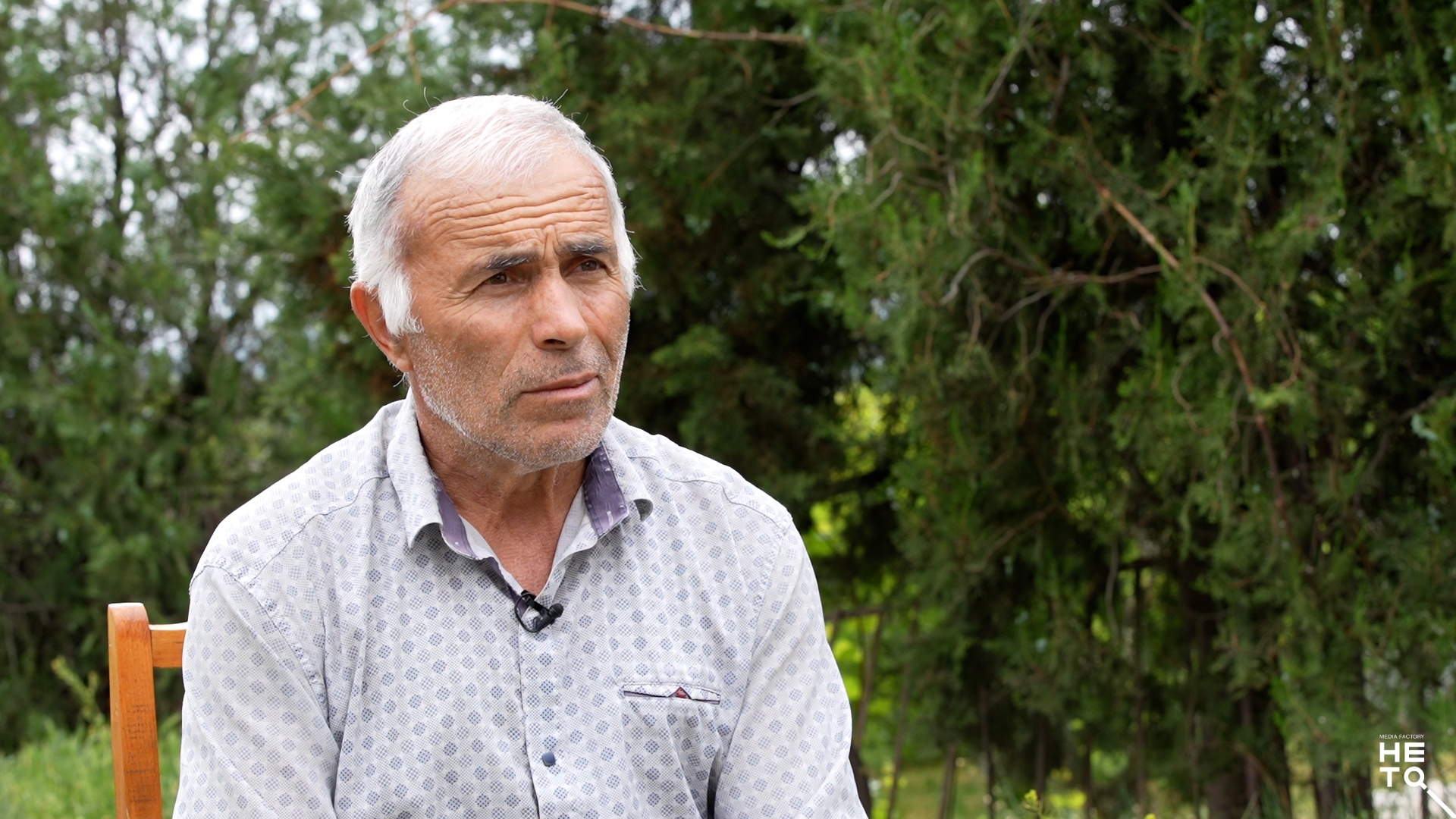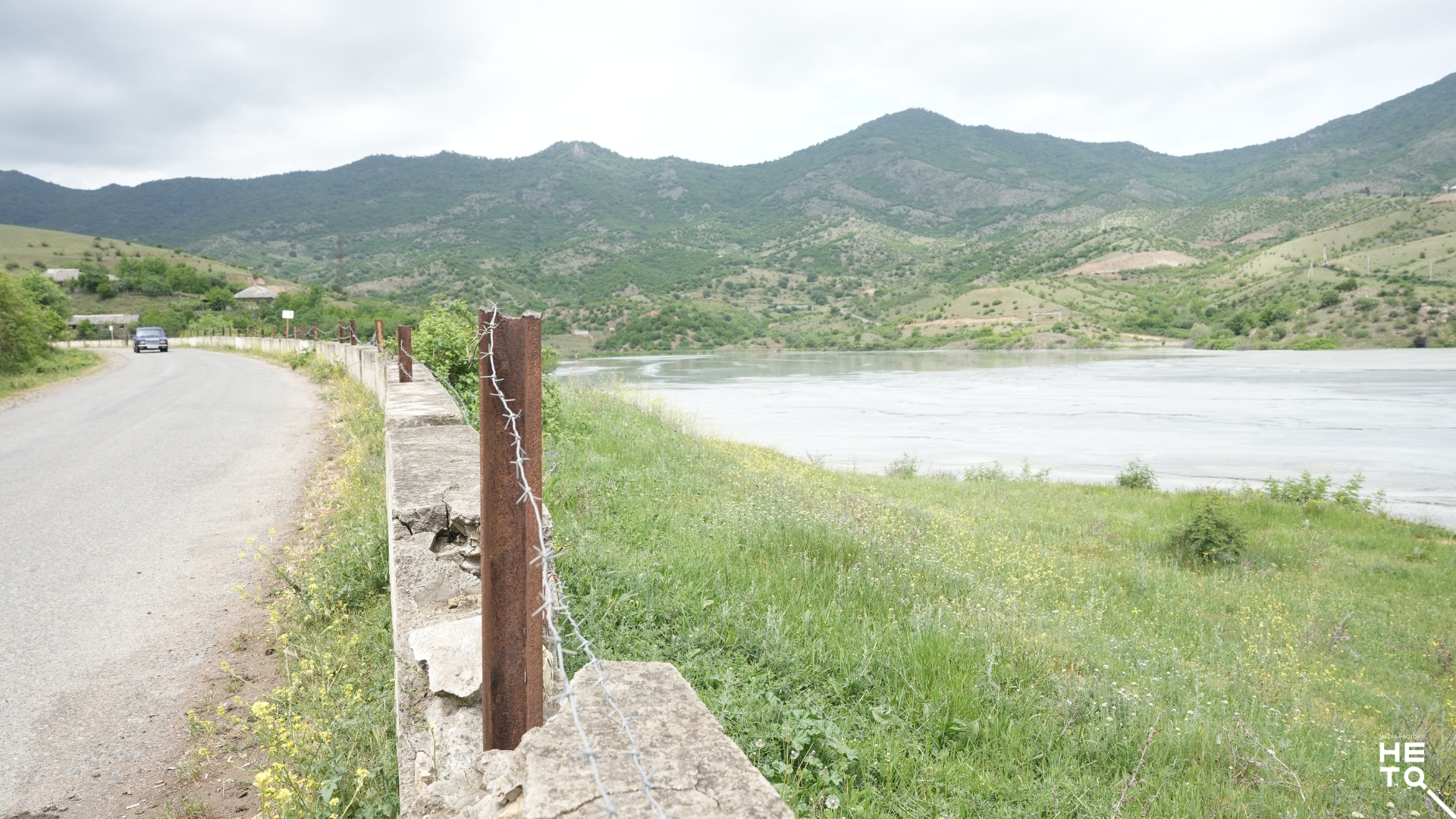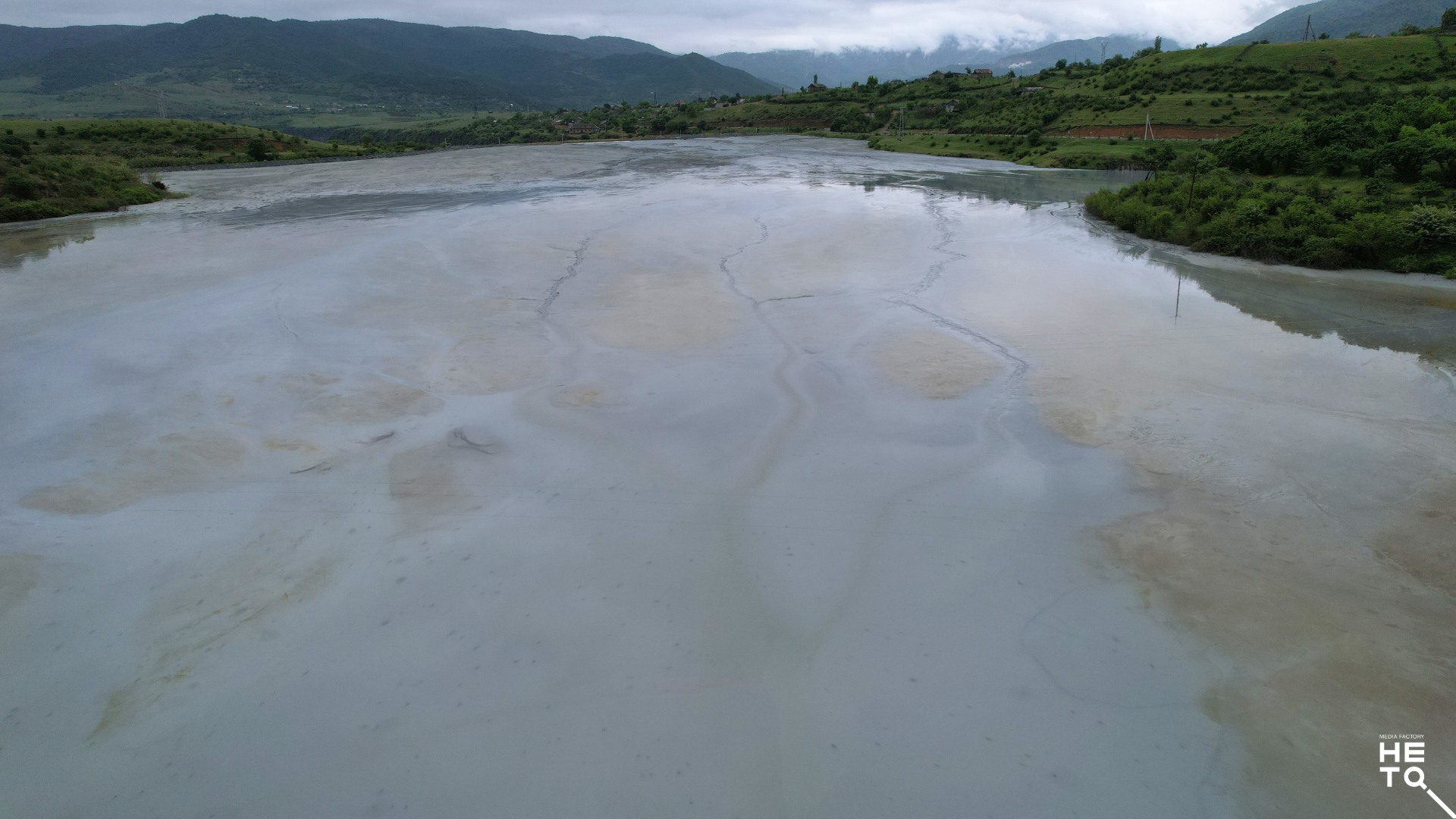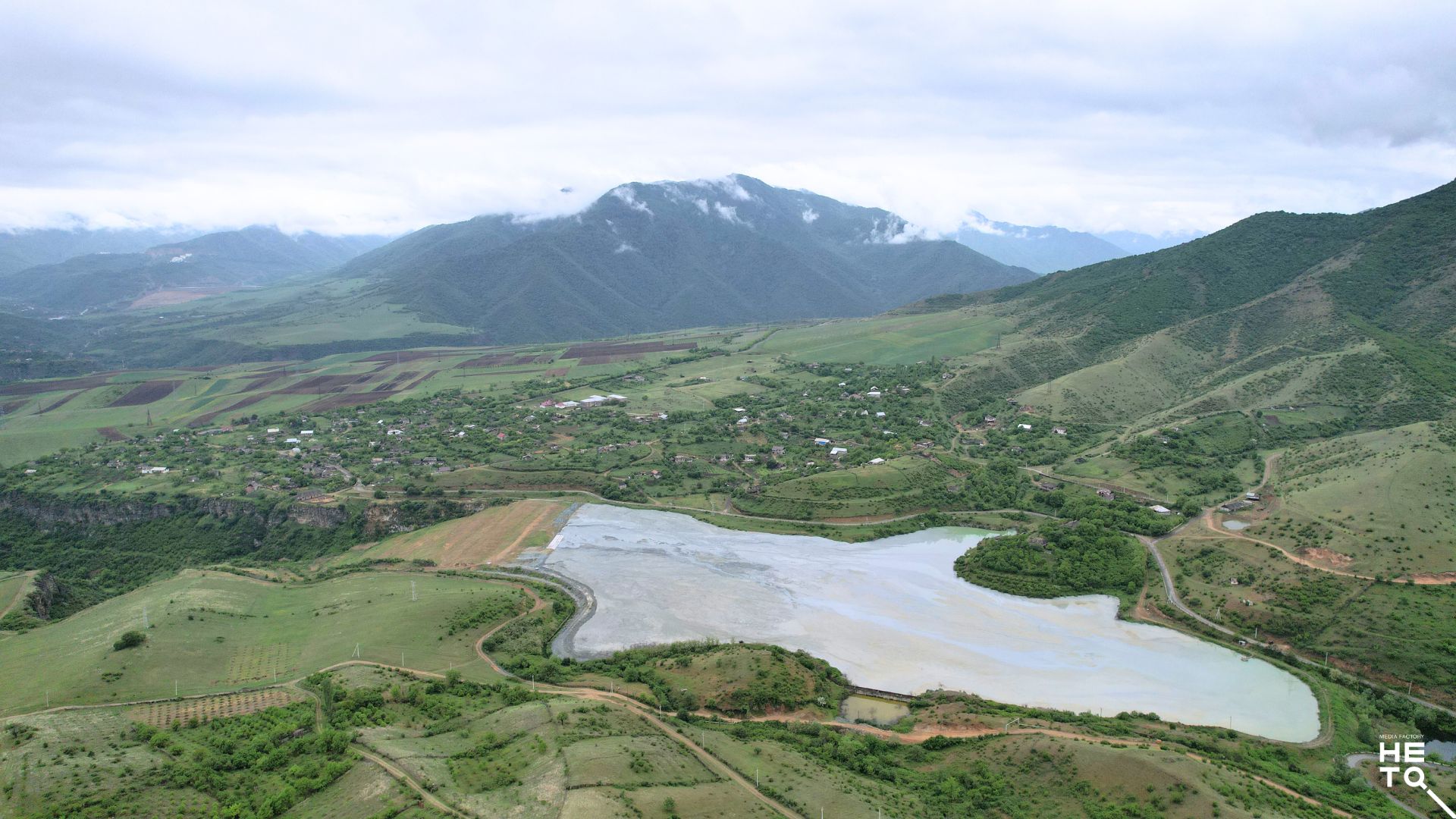What appears to be a picturesque lake in this photo is actually the Nahatak tailings dam, filled with toxic mining waste. In use since 1967, the tailings dam has gradually expanded, consuming more land over time. Its mirror surface alone (excluding the walls and other infrastructure) now covers an area equivalent to 24 football fields. The tailings dam has been a long-standing problem for the nearby villages. The long-delayed reclamation (restoration of the disturbed land) shows no signs of completion, and local residents continue to voice their concerns.
Nahatak is located in the enlarged Alaverdi community, between Chochkan and Mets Ayrum villages. It was named after the Nahatak River, a tributary of the Debed River, on the streambed of which it was built. Although the tailings dam has existed for 57 years, it was inactive between 1988 and 2009.
Nahatak tailings dam is operated by "Akhtala Mining and Enrichment Combine" CJSC, which extracts copper from the Shamlugh mine. The company has operated three tailings dams: "Nazik" (reclaimed, but with numerous defects), "Pahesti Dzor" (subject to reclamation), and "Nahatak" (currently undergoing reclamation).
Nahatak, with a projected capacity of 3 million m³, is the largest tailings dam. In the 2003 national report by the Ministry of Environment, it was identified as one of the three most dangerous tailings dams in Armenia. Over the years, the tailings dam has expanded and is now just 20-30 meters away from the houses of Mets Ayrum village. On the other side, nearby, lie the croplands of Chochkan.
The villagers filed a lawsuit against the Combine
Samvel Siradeghyan from Chochkan used to irrigate his peach orchard with water from the Debed River. Now, he no longer cultivates the orchard, and it has dried up. Samvel says that the reason is the river polluted with tailings.
"Even today, you can see a 15-20 cm yellowish layer that cannot be called soil. I don't know what kind of sediment it is. Almost nothing grows there; the land is useless," Siradeghyan complains.

In 2021, Samvel Siradeghyan filed a lawsuit against the Combine and the RA Government, seeking compensation for damages. His lawsuit, along with similar cases filed by other residents, were combined into a single legal proceeding. The plaintiffs argue that the tailings dam negatively impacts surrounding communities, as leakage contaminates their drinking and irrigation water.
The residents presented a study by the Czech NGO "Arnika" as evidence. From 2018 to 2021, the organization, in collaboration with Armenian partners, investigated heavy metals and persistent organic pollutants in the mining areas of Tumanyan and Stepanavan.
High levels of copper, zinc, lead, chromium, and arsenic were found in the soils of Akhtala and nearby settlements, including areas around the Shamlugh open mine and the Nahatak tailings dam. In Chochkan village, heavy metal contamination was also detected in a privately owned plot irrigated with Debed River water. Additionally, soil samples from Alaverdi and Chochkan revealed alarming levels of arsenic. The study emphasizes the urgent need for immediate and serious action.
In 2022, the Lori region court decided to terminate the proceedings, ruling that the case was inappropriate for civil court examination. The residents appealed to the Court of Appeals, which overturned the lower court's decision regarding the Combine and sent the case back to the Lori region court for further review (the decision to dismiss the claim against the Government remained in effect). The Combine petitioned the court to dismiss their claim based on the statute of limitations, but this petition was rejected. The trial is still in progress.
If their efforts in Armenia prove unsuccessful, the plaintiffs intend to appeal to the European Court of Human Rights. Samvel Siradeghyan states, “We will take our case to the European Court because the economic damage is significant, and it also affects our health.”
The tailings spill has led to criminal proceedings being filed.
The negative impact of the Nahatak tailings dam is sometimes felt in the neighboring Tavush region, through which the Debed River also flows. Oleg Dulgaryan, president of the "Center for Community Mobilization and Support" NGO based in Alaverdi, recalls that the most significant spill from Nahatak occurred in 2022.
"The residents of the Noyemberyan community raised alarms about tailings contaminating the Debed River, making it unusable for irrigating their lands. Some gardens had already been damaged," Dulgaryan says.
At that time, the Environmental Protection and Mining Inspection Body reported that an accident occurred on the night of July 27, 2022, in tunnel No. 3 of the Nahatak tailings dam, leading to a leak of tailings into the Debed River. The inspection body stated that the issue was addressed the following day. In response to our inquiry, the inspection body indicated that administrative proceedings were initially started for the incident, but the case was later referred to the Investigative Committee.
We learned from the Investigative Committee that a criminal case was opened for water pollution under Article 375 of the Criminal Code. The investigation is ongoing, and no one has been prosecuted so far.
Villagers claim that the tailings dam negatively impacts agriculture and their health
Villagers living near the tailings dam say that selling their harvest has become challenging.
Samvel Siradeghyan from Chochkan explains, “Buyers refuse to purchase the harvest when they learn it was irrigated with water from the Debed River.”
Livestock grazing is another challenge for residents. While warning signs are posted around the tailings dam, some areas lack fencing. Additionally, livestock can bypass existing fences and freely approach the Nahatak area in some places.

"There was no fence at all for 10 years. It was only installed 2-3 years ago, thanks to efforts by NGOs and the local residents. A couple of years ago, a resident of Chochkan village lost sheep that drank water from the tailings dam, but he didn't receive any compensation. The Combine told them to conduct an examination to confirm the cause of death," Oleg Dulgaryan says.
Arthur Grigoryan, former head of the Environmental Protection and Mining Inspection Body and expert in environmental law, states that the tailings dam should have been fenced from the very beginning,
“Fencing is a mandatory requirement. The tailings dam must be isolated from public areas, ensuring that neither people nor livestock can access the site.”
Davit Abgaryan, the chief engineer of Akhtala Mining and Enrichment Combine, mentions that while they prohibit access, people sometimes intentionally bring the livestock near the tailings, possibly because the vegetation in that area seems appealing.
Residents of Mets Ayrum also complain about an unpleasant odor coming from Nahatak.
"Children are experiencing allergic reactions. Residents of the village say that when they consulted doctors, the doctors attributed the allergies to living near the tailings dam, but no concrete evidence was provided," Oleg Dulgaryan says.
During our visit to Mets Ayrum, we observed that some residents had redness and blisters on their skin. For instance, 2-year-old Mher regularly develops a red rash on his hands, which his mother attributes to the tailings dam, located just 170 meters from their home and clearly visible from their balcony.

Mher's mother says, “When I take my child out of this area, the rash disappears. But as soon as we come back, the rash returns to the child's face. I initially thought it might be due to sweets, so I stopped giving him sweets for almost two months, but it didn't make any difference.”
Research by the "Arnika" organization revealed that arsenic levels in urine samples from 4, 10, and 13-year-old boys living in Alaverdi, Pokr Ayrum, and Shamlugh exceeded the safety limits set for workers in the Czech industrial sector.
"European countries have established standards. If, for instance, the standard set for a miner is exceeded, then the situation is critical. The levels recorded by the "Arnika" organization for our children are several times higher than these standards," Oleg Dulgaryan says.
His NGO, the "Center for Community Mobilization and Support," collaborated with the Czech organization.
The reclamation of Nahatak – a great odyssey
In March 2019, Samvel Khachatryan, the general director of Akhtala Mining and Enrichment Combine, informed "Hetq" that the Nahatak tailings dam would be reclaimed within a year once the new tailings drying and thickening workshop began operating. A few months later, in October, he stated that the new workshop was capable of drying and concentrating 80% of the tailings generated daily. These tailings are then transported by truck to Shamlugh, where they are filled in old mine pits and covered with soil. The remaining 20% of tailings generated from ore processing are still filled into the Nahatak tailings dam.
"Either the Combine should be shut down entirely to prevent further tailings from being filled into Nahatak, or we need to consider constructing a new tailings dam," Khachatryan had told "Hetq," adding that they still have space to raise the existing tailings dam wall by one meter, which would allow for its reclamation in two years.
In 2020, the Combine finally applied for the reclamation of the Nahatak tailings dam, and in July 2021, it received approval. The reclamation process was expected to take 2 years and 4 months. According to regulations, the work should have started within a year of receiving the positive conclusion by July 2022 and been completed by fall 2024 at the latest. However, the Combine initiated the process only in the spring of 2023, and it is still too early to determine when it will be completed.
The reclamation of the Nahatak tailings dam will be carried out in two phases: technical and biological. During the technical phase, the surface of the tailings dam will be leveled and covered with a geomembrane to separate the tailings from the rock layer placed on top. This rock layer will be 30 cm thick. In the biological phase, a 20 cm layer of fertile soil will be spread over the rock layer, and then herbs will be sown.

"For the first phase, we plan to reclaim two sites," says Davit Abgaryan, the chief engineer of the Combine. “The work on the first site is fully completed, and over 2 hectares of the second site have been reclaimed so far. The work continues.”
Oleg Dulgaryan finds the work done to be unsatisfactory.
"While some progress has been made, perhaps 20% of the tailings dam has been covered. However, we have not seen any efforts that would lead to full reclamation," Dulgaryan notes.
The chief engineer of the Combine explains the slowdown in reclamation work by pointing to weather-related challenges.
"Climatic conditions create certain obstacles that slow down the progress. The project clearly specifies that the second phase can only begin after the site has naturally dried, as heavy machinery will be used," he says.
The first phase of reclamation is still incomplete, and the natural drying of the tailings dam has also been delayed. Furthermore, the two tailings pipelines were supposed to be dismantled, but they were still in place during our filming on May 3rd. A video sent to us by locals on May 24th shows that new tailings are being poured into Nahatak.
Davit Abgaryan, however, assures that the tailings dam is not currently in use and that the substance flowing from the pipes is not tailings but sediment water left in the pipelines.
“It (the tailings dam - ed.) is not currently being used at all. If any issues arise during production, the shift may take 10 to 15 minutes to assess and address the situation.”
Environmental law expert Arthur Grigoryan points out that if the tailings dam was not supposed to be used for an extended period, yet new tailings are being poured there, evidence of this activity can be gathered through an inspection. He emphasizes that the only thing needed is a justification for conducting such an inspection.
The Environmental Protection and Mining Inspection Body oversees the reclamation work. The most recent inspections at Akhtala Mining and Enrichment Combine were conducted in 2018, revealing several violations. No inspections are scheduled for the Combine this year.
Arthur Grigoryan, the former head of the Inspection Body, explains, “The Inspection Body is responsible for overseeing about 5,000 economic entities. Among these, 1,000 are classified as high-risk. However, the Inspection Body cannot inspect all these high-risk entities, or any others, annually.”
Grigoryan points out that local residents can request an inspection by submitting a well-supported application to the Inspection Body. However, residents living near Nahatak did not make such a request, as they were unaware of this option.
What level of support does the Combine offer to the community?
The Subsoil Code requires miners to contribute to the socio-economic development of local communities as part of their subsoil use contracts. However, this requirement is not included in the 2012 contract between "Akhtala Mining and Enrichment Combine" CJSC and the Ministry of Energy and Natural Resources. Despite this, both the residents and the chief engineer of the Combine confirm that the company provides annual financial support to the community. This support was previously directed to the Akhtala community but is now allocated to Alaverdi, which has included Akhtala since 2022.
The report of the Combine indicates that financial support to the Akhtala community was as follows: 500,000 AMD in 2017. In 2018, a new agreement resulted in the community receiving 45 million AMD that year, followed by 60 million AMD annually in 2019 and 2020 and 80 million AMD in 2021.
Alaverdi Municipality, violating the Freedom of Information Law, did not answer our question about the current amount of money the Combine transfers to the community nor how the Municipality manages these funds.
Beyond investments focused on socio-economic development, the mining company also directs additional funds to the community, specifically to its affected settlements.
The Budget System Law dictates that 1% of the royalty paid by the mining company is divided equally among the settlements impacted by its activities. Additionally, another 1% of the royalty is distributed equally among all other communities in Armenia that have affected settlements.
An affected settlement is defined as the community situated directly next to the area allocated to the royalty-paying organization under the Mining Allotment Certificate.
Chochkan is considered an affected community, while Mets Ayrum is not.
The Minister of Territorial Administration and Infrastructure determines the list of affected settlements. According to this list, Akhtala Mining and Enrichment Combine has affected the town of Shamlugh and the village of Chochkan within the Alaverdi community. While Shamlugh has a copper mine, Chochkan, and Mets Ayrum are both adjacent to the Nahatak tailings dam. However, the reasoning behind excluding Mets Ayrum from the list of affected settlements remains unclear. Neither the Ministry of Territorial Administration and Infrastructure nor Alaverdi Municipality provided a clear explanation for this decision.
As a result, Chochkan, situated on one side of the Nahatak tailings dam, receives allocations from the Combine's royalty, while Mets Ayrum, which is only 20-30 meters away from the dam, is not classified as an affected community. Despite this, both villages are equally exposed to the unpleasant odor, regardless of the direction of the wind.

The chief engineer of the Combine expects the reclamation to be finished by 2026, but the current progress suggests this deadline may not be met. The Combine seems to be in no rush to fulfill its obligations, the Environmental Protection and Mining Inspection Body has not conducted a scheduled inspection at the Combine for six years, Alaverdi Municipality manages the funds from the miner without clear accountability, and the residents continue to complain to no avail.
This investigation was conducted within "Student Journalism Investigations" project by "Investigative Journalists" NGO with the support of the Friedrich Naumann Foundation for Freedom South Caucasus Yerevan Office.
The views and opinions expressed in this investigation do not necessary reflect the position of the Friedrich Naumann Foundation for Freedom and its employees.

Authors
Students
Emma
Vardanyan
Students
Maria
Khachatryan
Students
Anzhela
Aghamyan
Instructors
Instructors
Vahe
Sarukhanyan
Instructors
Mariam
Barseghyan
Team
Team
Harutyun
Mansuryan
Team
Lilit
Tarkhanyan